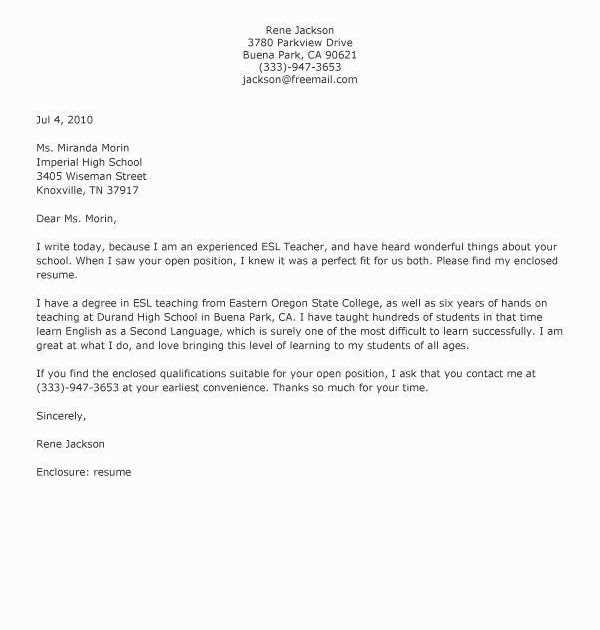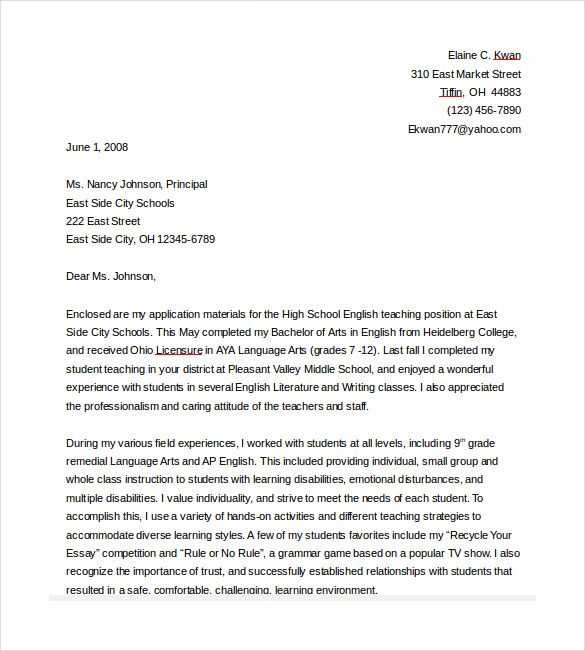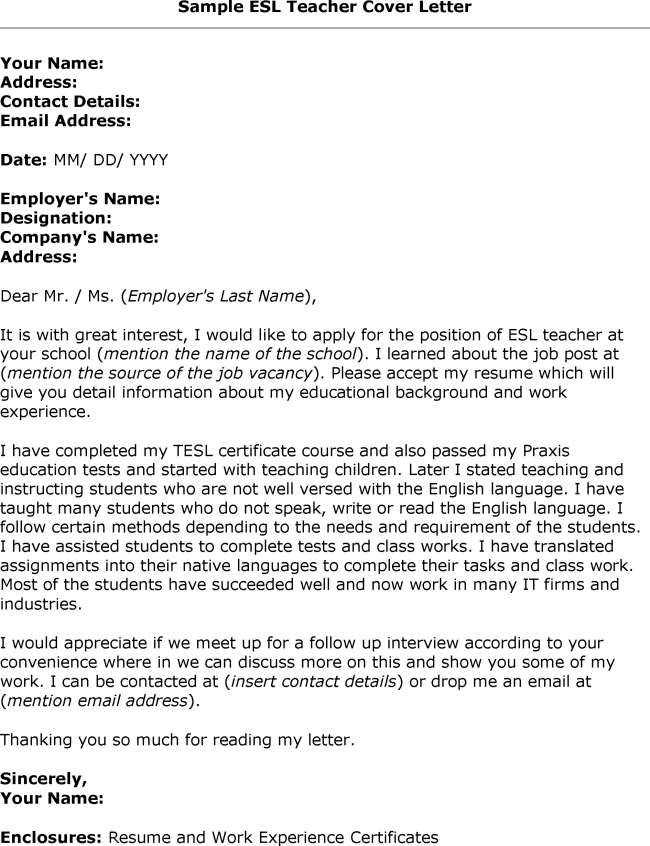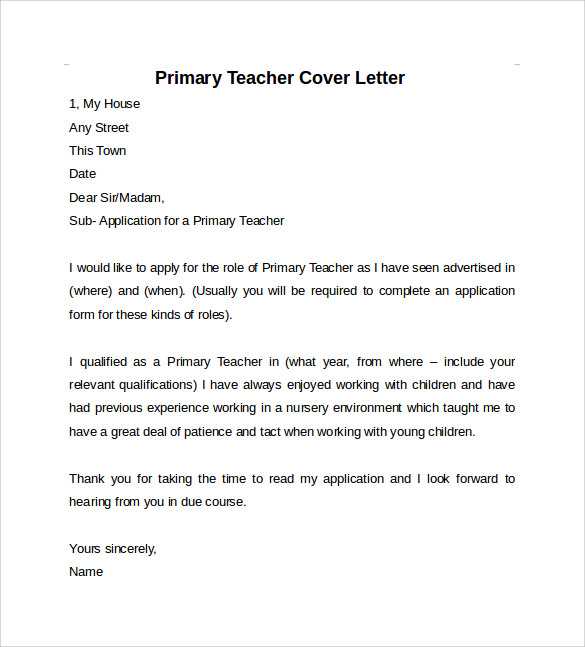English teacher cover letter template

Crafting a strong cover letter is a key step in securing a teaching position. Focus on highlighting your experience, skills, and passion for teaching in a clear and concise manner. This approach allows you to stand out from other applicants, providing a snapshot of what you bring to the table.
Start by addressing the hiring manager directly. Use their name if possible to make the letter more personal. Mention the position you’re applying for and where you found the job listing. In the first paragraph, briefly explain why you’re excited about the opportunity and how your background aligns with the job requirements.
In the second paragraph, delve into your qualifications. Showcase your teaching experience, certifications, and any specific skills that make you an ideal candidate. Emphasize how you’ve helped students succeed and improved learning outcomes in your previous roles. This is your chance to demonstrate that you are not just a teacher, but someone who makes a difference in students’ lives.
The closing paragraph should express your enthusiasm for discussing the role further. Politely indicate that you look forward to the opportunity to interview. Make sure to thank the hiring manager for considering your application, and sign off professionally.
English Teacher Cover Letter Template

Begin your letter by addressing the hiring manager directly, using their name if possible. Avoid generic salutations like “To whom it may concern.” Tailor your opening to show that you’ve researched the school and are genuinely interested in the position.
Next, explain why you’re applying. Mention specific skills and experiences that directly align with the job description. For example, highlight your experience in teaching English as a second language, preparing lesson plans, or using innovative methods to engage students. Be clear and direct about how your qualifications match the role.
In the body of your letter, provide examples of how you’ve helped students improve their English skills. Whether it’s through tailored lesson plans, interactive activities, or a commitment to individualized attention, demonstrate measurable results. Quantify your achievements whenever possible (e.g., “Increased student proficiency scores by 20% through tailored tutoring sessions”).
Conclude with a strong closing paragraph. Reaffirm your enthusiasm for the role and express your interest in an interview. Avoid generic phrases like “I look forward to hearing from you.” Instead, state that you’d welcome the opportunity to discuss your application further.
Finally, end with a professional sign-off such as “Sincerely” or “Best regards,” followed by your full name. Make sure to include your contact details and thank them for considering your application.
How to Address the Hiring Manager
Use a formal greeting to show professionalism. Avoid generic terms like “To whom it may concern” unless you have no other option. Instead, aim for a specific name whenever possible.
If You Know the Hiring Manager’s Name
- Use the person’s title followed by their last name, such as “Dear Mr. Smith” or “Dear Dr. Johnson.”
- Ensure the spelling of the name is correct and address them appropriately based on their title (e.g., Ms., Mr., Dr.).
If You Don’t Know the Hiring Manager’s Name

- Try to find out the name by checking the job listing, company website, or calling the company directly.
- If you cannot find a name, use “Dear Hiring Manager” as a neutral alternative.
- Avoid vague or outdated greetings like “To whom it may concern” unless absolutely necessary.
Personalizing your greeting increases the chances of making a good impression. Keep it simple and professional, focusing on the correct salutation.
Key Skills to Highlight for Teaching English
Focus on communication skills. As an English teacher, you need to convey ideas clearly and in a way that engages students. Use simple language, adjust your tone for different situations, and practice active listening to ensure students understand your points. Strong communication goes beyond speaking–effective written communication is equally important, especially for lesson plans and feedback.
Adaptability is a skill that stands out. Tailor your teaching methods to suit different learning styles, whether students are visual, auditory, or kinesthetic learners. Adapt your materials and teaching strategies to ensure everyone has access to the content in a way that suits them best.
Classroom management plays a key role. Create a positive learning environment where students feel comfortable participating. Set clear expectations and maintain structure while allowing room for creativity. This helps foster a space where students can thrive without distractions.
Proficiency in grammar and language structure is non-negotiable. It’s crucial to teach students the rules of the language, but also how to apply them in real-world situations. Knowing how to break down complex grammar topics and explain them in an accessible way will help students gain confidence in their language skills.
Patience is another skill that can’t be overlooked. Progress takes time, and students may need additional support or practice before mastering a concept. Approach each challenge with a calm demeanor, understanding that setbacks are part of the learning process.
Technological proficiency is increasingly significant in today’s teaching. Being familiar with educational software, online platforms, and digital resources can enhance lesson delivery. Integrating technology in the classroom can engage students and make lessons more dynamic and interactive.
Tailoring Your Experience to the Job Description
Highlight the skills and experiences that match the specific qualifications listed in the job description. Focus on the key requirements mentioned by the employer and align your achievements with those points. Use concrete examples to demonstrate how your past roles directly relate to the job you’re applying for.
Identify Key Skills and Requirements
Carefully read through the job posting and underline the core skills or qualifications. Compare them with your resume and pick experiences where you applied those skills successfully. Be specific about how your expertise in areas like classroom management, lesson planning, or student engagement fits with the needs of the role.
Use Keywords from the Job Description
Incorporate language from the job description into your cover letter. This shows that you’ve paid attention to the details and are presenting yourself as a perfect match for the position. If the employer mentions specific tools or methodologies (e.g., online learning platforms, project-based learning), emphasize your familiarity with those areas.
Crafting a Compelling Opening Paragraph

The first sentence sets the tone for your cover letter, so make it impactful. Open with a strong statement about why you’re excited about the position, whether it’s the school’s values, its teaching approach, or its community. Be specific about your interest in the role, showing you’ve researched the institution and understand what they need. This not only grabs attention but also demonstrates that you’re genuinely interested and prepared.
Be Specific About Your Skills
Avoid generic phrases. Instead, mention key skills you bring to the position. For example, if you have experience integrating technology into lessons or working with diverse student groups, make sure to mention this right away. Highlighting what makes you stand out from other candidates will give the reader a reason to continue reading.
Connect Your Background to the Job
Link your qualifications to the responsibilities outlined in the job description. If the position calls for a creative approach to teaching English, describe how your previous roles have prepared you for this challenge. Draw clear connections between your experience and the job’s requirements.
| Tip | Example |
|---|---|
| Highlight Relevant Skills | “With my extensive background in developing interactive English curricula, I am excited to bring innovative teaching methods to your school.” |
| Personalize Your Interest | “Your school’s commitment to fostering a supportive learning environment resonates deeply with my teaching philosophy.” |
Using Specific Examples to Demonstrate Teaching Success
Highlight key moments in your teaching career to showcase the impact you’ve had on students. Provide clear, measurable examples of how your teaching methods led to improved student outcomes or engagement. Rather than general statements, focus on moments where your intervention directly influenced student progress.
Showcase Student Achievement
- For example, mention how a tailored lesson plan helped struggling students improve their reading comprehension by 20% within a semester.
- Describe a successful classroom project that encouraged students to collaborate, resulting in a class-wide increase in problem-solving skills.
- Highlight individual student successes, such as a student who, with your guidance, improved their writing scores on standardized tests.
Demonstrate Classroom Innovation
- Detail an innovative teaching strategy you implemented that motivated students to engage more with difficult topics.
- Share how you incorporated technology in the classroom to provide interactive learning experiences, leading to greater student participation.
- Describe how a change in classroom structure, such as group work or flipped learning, enhanced student collaboration and understanding.
Finalizing Your Letter with a Professional Closing
End your cover letter with a courteous and confident closing statement that reinforces your enthusiasm for the position. A strong closing can make a lasting impression on the reader.
For a polished conclusion, use phrases like “I look forward to the opportunity to discuss how my skills align with your needs” or “I am eager to bring my expertise to your team.” These statements emphasize your readiness without sounding presumptuous.
Choose a professional sign-off, such as “Sincerely,” “Best regards,” or “Kind regards.” These are widely accepted and reflect respect for the recipient. Avoid overly casual closings like “Cheers” or “Best wishes,” as they may not convey the right level of professionalism.
After the sign-off, include your full name. If submitting a printed version, leave space for your signature above your typed name.